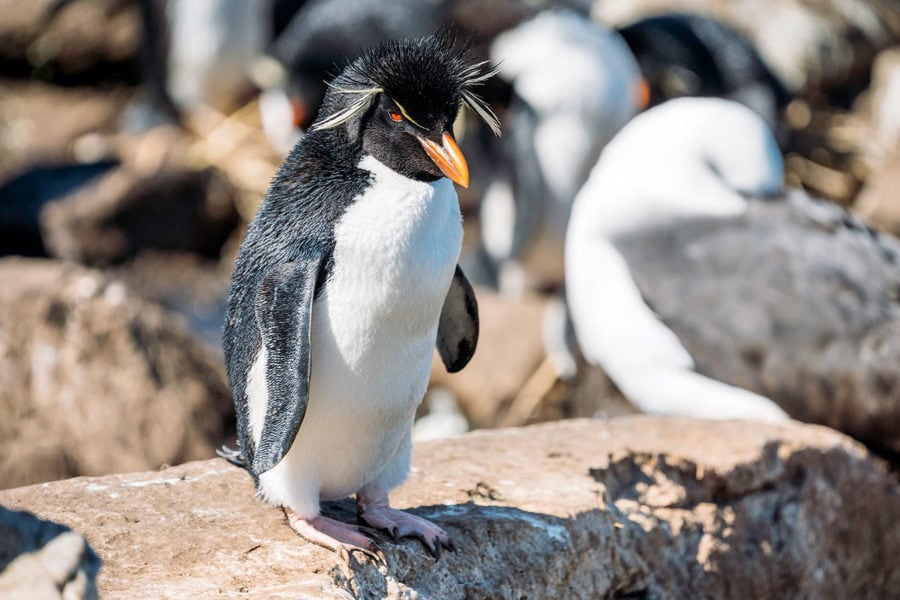
Travel Photography from Antarctica
Antarctica Photo Essay
Visiting Antarctica has been a dream of mine ever since I started traveling, and it finally became a reality. Here are some of my favorite Antarctica pictures from our trip!
I recently returned from a 20-day Antarctic cruise to the Falkland Islands, South Georgia, and the Antarctic Peninsula with Quark Expeditions.
From beautiful white-sand beaches on the Falkland Islands, to the incredible wildlife colonies of South Georgia, and of course the icebergs and mountains of Antarctica itself — I shot well over 6000 photos during the entire journey.
Below you’ll find a collection of my best pictures of Antarctica mixed in with images from the other spectacular & remote islands we visited along the way.
While photography can never truly capture the unreal experience of seeing Antarctica in person, I hope these photos will inspire you to visit the world’s 7th continent someday!
Map Of Our Antarctic Voyage

Antarctica Route Map
1. Proud King Penguins

March of the King Penguins!
Did you know there are 17 different species of penguins around the world? You can find 8 types of penguins in Antarctica and the surrounding islands. These are King penguins, known for the vivid orange color on their heads and chests. They are very large penguins, about 3 feet tall.
We found this group of kings strolling across a section of sand dunes on Saunder’s Island in the Falklands, the first stop on our voyage. I have hundreds of penguin photos, but this one is my favorite. They look like they’re dressed in suits commuting to work. On the beach! In formation with a purpose.
2. Melting Antarctic Glaciers

Massive Glacier in Antarctica
One of the most striking parts of visiting Antarctica for me was the number of glaciers. Imposing walls of ice & snow hanging precariously off the edge of the continent. Occasionally we’d hear the CRACK! from a large piece splitting off and calving into the sea.
One of my Antarctica photography goals was to capture a calving glacier on film, and after spending wayyyyy too much time trying, I luckily managed to do it (which I’ll be sharing soon)! Unfortunately Antarctica’s glaciers are melting at an unprecedented pace due to climate change.
3. Nesting Gentoo Penguins

Blending in with the Locals
This is Useful Island, a small island just off the coast of the Antarctic Peninsula. It’s home to a colony of Gentoo penguins. The penguins feed on a combination of krill, fish, and squid — all of which are plentiful in these waters.
Gentoo penguins prefer to make their circular nests on bare rocks around the Antarctic, using small pebbles and stones. Sometimes one penguin steals stones from his neighbor’s nest when they aren’t looking, and it’s pretty funny to watch!
4. Antarctica’s Iceberg Islands

Massive Amounts of Ice!
I have a fascination with icebergs. These large chunks of ice that have fallen off glaciers can float across the ocean for 10 years or more, and come in a variety of shapes, sizes, and colors. The iceberg picture opportunities in Antarctica are awesome!
I’m sure you know that about 90% of an iceberg is actually hidden beneath the water’s surface. We were not allowed to get too close to them, because they often flip or break apart violently and without warning, making them dangerous.
5. Dirty Chinstrap Penguins

Chinstrap Penguin Colony
Chinstrap Penguins are named after the black neckband that makes it look like they’re always grinning. These little penguins can be found most often near the Antarctic coastline, but will also hitch a ride out on icebergs floating into the middle of the sea.
You can always tell which penguins are taking care of the nest, and which have just returned from hunting in the ocean by how dirty they are. This group has obviously been on nest duty for a while!
6. Stunning Antarctic Sunsets

Purple Sunset in Antarctica
The Antarctic tourist season lasts from November to March, which is summertime in the Southern Hemisphere. Because you are so far South, the sun sets much later than normal. Around 11pm in November when we were visiting.
While you might be super tired from all the fun daytime activities during a trip to Antarctica, I highly recommend heading out on the ship’s deck to catch the amazingly colorful (and long) sunsets for some great photos!
7. Funny Rockhopper Penguins

Rockhopper Penguins
More penguins! This is the Southern Rockhopper, named after its signature “hopping” style to get around, rather than the typical . With blood red eyes, an orange beak, pink feet and those crazy yellow tufts of feathers around the eyes, this penguin stands out!
They breed amongst tall tussock grasses on rocky coastlines of islands in the Southern Hemisphere and around Antarctica. We came upon this colony in the Falkland Islands. Rockhoppers return to the same breeding ground, and even nest, every year. They try to locate the same mate too!
8. Humpback Whales Feeding

Humpback Whale Watching in Antarctica
What kind of camera gear did I bring to shoot photos in Antarctica? Along with my Sony A7R III, I decided to rent a 2nd camera body (Sony A7 III) from LensRentals.com. I also rented a 100-400mm telephoto lens to capture close-up wildlife shots like this humpback whale tail.
This way, I could have a wide 24mm-70mm lens on one camera, and the telephoto lens on the other. Always ready for action. When a humpback is about to deep-dive & show off its tail, it will arch its back more than normal. Giving you a few extra seconds to prepare for the “money shot” in advance.
9. Rare Macaroni Penguins

Are you sick of Penguins yet?
Very similar looking to Rockhoppers, witnessing Macaroni penguins during our Antarctica trip was a special treat, because they can often be difficult to find. Macaronis prefer to nest on very remote and exposed rock outcroppings that are challenging for humans to reach.
Luckily our ship’s wildlife expert happened to discover a colony, and we used our zodiac boats to maneuver in close. They were named “Macaroni” after the 18th-century English fashion of wearing outlandish clothing & wigs!
10. Falkland’s Albatross Colony

Black-Browed Albatross Colony
The Falkland Islands are a birder’s paradise. While I’m not a bird fanatic myself, many guests on our expedition were. However even I couldn’t deny how cool the Black-browed Albatross is. It’s a very loud, and very large sea bird! Their wing span can reach up to 8 feet (2.5 m).
Watching them preen and look after their single egg on nests made of mud and grass along the edge of the ocean was a special treat. There were thousands of them, sharing the breeding ground with a colony of Rockhopper penguins who were also nesting there.
11. Sea Kayaking In Antarctica

Kayaking in Antarctica
Yes, you can go kayaking in Antarctica! Our ship offered 2 options, traditional sea kayaking in a hard-shell kayak, or an inflatable sit-on-top kayak. Both options require you to wear what’s called a “dry-suit” that’s basically a waterproof suit covering warm layers underneath.
Kayaking in Antarctica allows you to get away from the ship and the zodiac boats, so you can really experience the profound silence in this remote part of the world. Gliding quietly over the surface of the ocean past icebergs, watching seals and penguins swim beside you.
12. Playful Orcas (Killer Whales)

Well hello there!
Orcas truly are the top of the food chain. Did you know they attack and kill Great White sharks just to eat their livers?! We got crazy lucky and were able to watch a large pod feed on schools of fish, before then starting to chase a group of penguins too!
This is a single frame from a GoPro video I shot underwater at the end of a long pole, as one of the Orcas swam by our boat to take a closer look at us. It was one of the most amazing wildlife moments I’ve ever experienced during my travels so far. Make sure to watch the full video at the end of this article!
13. Blood Thirsty Ducks?

This Cute Duck Eats Raw Flesh…
Meet the South Georgia Pintail, a small & curious duck that calls the sub antarctic region home. Yes a duck! And not just any duck, this thing has an appetite for raw meat. Along with algae, it eats shrimp, clams, snails, and likes to pick through the dead carcasses of seals.
South Georgia Pintails were once threatened by the introduction of rats to the island which often ate their eggs, as well as whale hunters who would eat the birds themselves. They’ve made a comeback though, now that whaling is illegal on and around South Georgia.
14. Fighting Elephant Seals

Young Elephant Seals Fighting
Elephant seals are BIG animals! Males can reach 20 feet long and weigh up to 8000 pounds (4 tons!) I caught these two young males fighting each other pretty aggressively, and drawing blood, as a sea of penguins watched.
Dominant male elephant seals collect a harem of 40-50 females, fighting off other males who attempt to infiltrate the group. At one time these animals were on the brink of extinction due to over-hunting for their blubber, but with legal protections their numbers have returned to normal.
15. Rugged Mountain Ranges

Mountain Range in Paradise Harbour
Antarctica isn’t just a massive sheet of ice. It also boasts large (and beautiful) mountain ranges, like the pictured here at our stop in Paradise Harbour. There are three notable ranges that spread across the continent: the Transantarctic Mountains, the Antarctandes and the Sentinel Range.
The highest mountain in Antarctica is Mount Vinson at 16,405 feet (4892m). It’s part of the famous “7 Summits” challenge that some hardcore climbers (with a lot of money) attempt to complete for bragging rights.
16. Small Adélie Penguins

Pair of Adélie Penguins
This was the only time we were able to see this type of penguin on our trip. Adelie penguins are very small, only about 2 feet tall. They spend their time on the Antarctic continent and the surrounding islands, but in the winter they stay offshore around the pack ice.
Adelie’s may travel up to 185 miles just for a single meal, and they’re excellent swimmers. They generally lay 2 eggs, taking turns keeping them warm. This species is one that’s actually thriving, and their numbers have more than doubled in recent years.
17. Epic South Georgia Landscapes

Rugged Coast of South Georgia
I know I said this was a showcase of pictures from Antarctica, but I’m sure you’ve noticed quite a few images without much snow in them. While visiting Antarctica was amazing, our time at the remote island of South Georgia was equally special.
Located about 2500 miles (4,150 km) away from Antarctica, and South Georgia is teeming with wildlife. Along with a very impressive collection of mountains, glaciers, and icebergs of its own. Adding South Georgia to an Antarctica trip makes the voyage much longer and more expensive, but I think it was worth it.
18. Earnest Shackleton’s Grave

Sir Ernest Shackleton’s Resting Place
If you haven’t read the book Endurance about Earnest Shackleton’s failed Antarctic expedition of 1914, put it at the top of your travel book reading list! Shackleton led an expedition to cross Antarctica that was scrapped when their ship was destroyed by crushing sea ice.
He then led his team over the frozen ocean to safety, rowed 1300km to South Georgia (where he’s now buried), and crossed treacherous mountains to launch a rescue mission. Everyone survived despite impossible odds, and unimaginable difficulty. One of the best adventure stories of all time.
19. Antarctica Research Station

Almirante Brown Research Station
This is Brown Station, an Argentine scientific research station on Coughtrey Peninsula in Antarctica. Established in 1951, it was burned down in the 80’s by the station’s doctor to protest an order to spend the winter there. One of a handful of crimes committed in Antarctica.
These days the rebuilt station is only open during the summer, and is also used as a popular landing spot for Antarctic cruises like ours. It’s home to a colony of Gentoo penguins, and has scenic lookouts you can hike up to with great views of Antarctica’s stunning Paradise Harbour.
20. Abandoned Whaling Boat

Rusting Whale Catcher at Grytviken
Whaling was a very profitable operation in the waters around Antarctica during the early 20th century. Whales were numerous down here, and “easy” to catch. The resulting whale oil was sold for use in lighting, lubrication, and leather tanning. It could also be hardened and turned into margarine and soap.
This old rusting “whale catcher” at Grytviken Station in South Georgia is a relic of that industry — look closely and you’ll see the harpoon at the bow and the on the mast, where sailors sat to spot whales. Thankfully whaling is now illegal here, and populations have been slowly making a comeback.
21. Half A Million Penguins!

St. Andrew’s Bay Penguin Colony
St Andrews Bay in South Georgia is home to a massive colony of King Penguins, over 250,000 breeding pairs. Penguin colonies are measured in “breeding pairs” because at any one time, half the penguins might be at sea fishing, and many baby penguins might not make it through the winter.
So in reality there are over 500,000 penguins living here. One of the first things that struck me after landing at St. Andrews was the sheer volume of sound from all these birds chatting away together! I’ve never experienced anything like it.
22. Fluffy Baby Penguin Chicks

Baby Penguins are Too Cute!
This is a baby King Penguin. It looks completely different than its parents, brown and fluffy with soft down feathers to keep it warm in the wind. King Penguins have one of the longest breeding cycles of any bird at 16 months.
During the harsh winter, penguin chicks will have to stand around in the cold for weeks waiting for their parents to return from the ocean with a meal. Many don’t make it, and only the strongest survive.
23. Aggressive Fur Seals

Fur Seal on South Georgia
No, there are no polar bears in Antarctica. But there IS an animal you have to be careful of — fur seals! You’ll find these guys all over the place, and navigating through them can be a challenge. While they may look cute, they have no problem charging you (or taking a bite) if you get too close.
Fur seals have very sharp teeth, and are extremely territorial. One of our guides actually got bitten in the leg during our Antarctica trip. Luckily he had many layers on, and no skin was broken. But a fur seal bite can quickly get infected, so it’s important to keep your distance from these guys.
24. Antarctica Expedition Ship

The Ocean Endeavour
We traveled to Antarctica on the Ocean Endeavour, a 30-year old ship built in Poland and leased to Quark Expeditions. There were 199 passengers and 115 crew members. While you could certainly feel the motion of the ocean under your feet, overall it was a pretty mellow journey. Even the notorious Drake Passage was calm!
The ship had great food, plenty of deck space, a spa, gym, sauna, and even a heated pool! The cabins were cozy but comfortable. There was free WhatsApp messaging, or you could purchase a full WiFi package for $100 that worked pretty well for uploading photos (not video though).
25. The Polar Plunge!

Me Diving into the Ocean!
You can’t visit Antarctica without attempting the infamous ! Because what sane person wouldn’t want to strip down and dive into the icy ocean surrounding Antarctica? While it sounds crazy, diving into 33F degree water with icebergs floating by wasn’t as bad as I thought it would be.
Yes, it shocks your body, but not so badly that you can’t think clearly. And with the amount of endorphins and adrenaline pumping through your veins, you barely feel the cold once you get out! In fact, I felt AMAZING afterwards.
Ready To Visit Antarctica?
I hope my photos of Antarctica have helped inspire you to visit one day in the future! How does one visit Antarctica you ask? Well, it’s not cheap.
Trips to Antarctica cost between $5000 – $12,000 (or more) depending on the length of the trip, number of stops, the operator, and other details. We saved up for a while & paid for it ourselves.
There are ways to save money on a trip to Antarctica though, for example by booking your trip very early. We booked our voyage with Quark Expeditions a full year in advance!
The Environmental Impact
Cruise ships are not environmentally friendly — at all. So traveling to Antarctica was a tough decision for me.
While Quark has a track record of offsetting their carbon emissions, and I offset my own portion (air and ship travel) with a donation to the Antarctic & Southern Ocean Coalition, we are still leaving an impact by visiting.
There are very strict regulations regarding tourism in Antarctica and the surrounding islands governed by an organization called IAATO.
We had to clean our own boots, pants, and backpacks before and after every landing to avoid contaminating the area with foreign plants, insects, or bacteria. Only 100 people are allowed to land at one time too.
While no tourism is perfectly environmentally friendly, I felt better about my trip after witnessing how seriously they take the “leave no trace” attitude. ★
BONUS ANTARCTICA VIDEO: Orcas Chasing Penguins!
Subscribe to my YouTube Channel for new Adventure Travel Videos!
(Click to watch THE GREAT ESCAPE! | Penguin VS Orcas Antarctica on YouTube)



